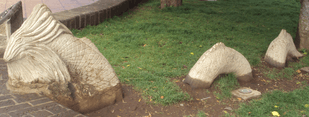Legend of Trentren Vilu and Caicai Vilu
The legend of Trentren Vilu and Caicai Vilu is a Mapuche flood myth that tells the story of a fierce battle between two mythical snakes, Trentren Vilu (trentren="related with the earth", vilu="snake") and Caicai Vilu (Caicai="related to water", vilu="snake"). It explains how the south of Chile came to have its accidented geography.
Myth


According to the Mapuche, these two snakes were originally the children of the most powerful pillans, who were converted into their animal forms as punishment. Peripillán's son was turned into a huge snake that would be Caicai and Antu's son turned into a huge snake that would be Tenten. They were to be enemies, just as Antu and Peripillán were. Caicai was sent to live in the sea to help care for it with the Ngen-ko (water spirits), and Tenten was sent to live on earth to help care for the earth with the other Ngen, and to help humanity; thus these two snakes were used as an instrument through which the will of the ancient Mapuche spirits was fulfilled.
It is said that after Caicai awoke from his years-long slumber, he became enraged because of the ungratefulness that men showed for every gift given to them by the sea, and desired to punish humanity and to incorporate all terrestrial life to his dominions. Caicai used his fish-shaped tail to hit the water, causing a great flood, since Caicai ordered the waters to flood the valleys and hills, and to bring all its inhabitants to the bottom of the sea.
Humans invoked the help of Tenten, who saw that both humans and animals were desperate. By order of her father, she was the one who had to provide them with wisdom and protection, so she decided to help humanity. She helped the people and the animals to escape by raising them on her back and taking them to the hills; and she transformed into birds those who were trapped by the waters, so they could escape by flying; those who were drowning into fish and marine mammals (one of them being the origin of the cahuelche (talking dolphin)), and those who had already drowned into sumpall (Mapuche mermen and mermaids). Those who were immobilized by the terror they felt, were transformed into mankial (petrified). But as the sea continued to rise, Tenten had to order the hills to increase in height to counteract the power of Caicai. Angry, Caicai began to fight against Tenten in a titanic battle that lasted a long time, until both snakes were tired. Caicai was partially defeated as he wasn't able to flood all the land, however, the waters did not return completely to their old level, giving Chile its current geography.
According to Chiloé tradition, Caicai was satisfied with the portion of land that he had managed to flood, and delegated his functions pertaining to the sea to the great Millalobo.
According to Mapuche tradition, after the cataclysm, everyone continued their quiet life; until one day it was Tenten who was angered by the attitude that men had, and made all the volcanoes erupt and the population had to move to other safer places. From that moment on, Tenten continues to manifest itself through earthquakes and volcanic eruptions, while Caicai causes tidal waves and floods when he rolls over during his sleep.
Similar myths
A variant of the myth tells that Caicai's anger against human beings began because a girl rejected her son, the Trauco.
Some Huilliche communities of Chiloé say that the battle originated because a daughter of the Trauco rejected the pillán Peripillán, and for this reason her son decided to take revenge.
In Argentina there are other later versions of the myth, which change the original parents of both mythical snakes, indicating that they would be brothers and/or sons of the gods Nguenechèn and Kueyen.
See also
- Deluge myth
- Mapuche mythology
- Chilote mythology
References
- Tom D. Dillehay. Monuments, empires, and resistance: the Araucanian polity and ritual narratives. Cambridge studies in archaeology. Cambridge University Press, 2007. ISBN 0-521-87262-6, ISBN 978-0-521-87262-1